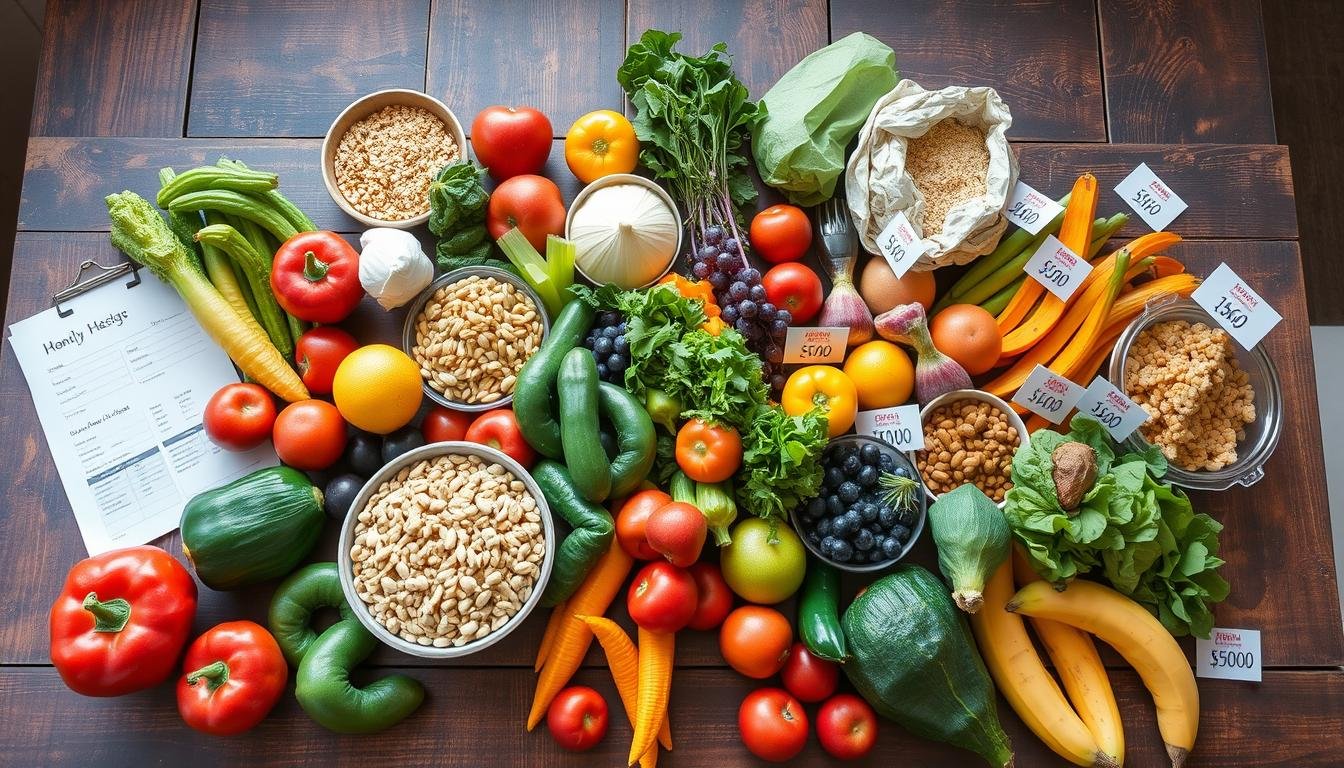In today’s fast world, eating healthy can seem expensive. But, it’s not true. You can eat well without spending a lot. This guide will show you how to make healthy meals without breaking the bank.
Whether you’re busy, a student, or a family trying to save money, this article has you covered. You’ll learn about meal planning, using leftovers, and the benefits of seasonal and plant-based foods. These tips will help you stretch your grocery budget and stay healthy.
Let’s explore how to eat healthy without spending too much. By the end of this guide, you’ll know how to reach your nutrition goals without hurting your wallet.
Meal Planning: The Key to Saving Money
Effective meal planning is a key to eating healthy without spending a lot. Start by making a weekly menu with affordable recipes and ingredients. This method helps you shop smarter, waste less food, and have healthy meals ready.
Creating a Weekly Menu
Creating a weekly menu can save you money on food. Spend a few minutes each week planning your meals. This way, you buy only what you need, avoid impulse buys, and use seasonal produce.
Utilizing Leftovers
Learning to use leftovers is a great way to stretch your food budget. Instead of throwing away extra food, turn it into new dishes. Use leftover chicken, veggies, or grains in soups, salads, or casseroles. This way, you get the most out of what you’ve already bought.
| Meal Planning Strategies | Benefits |
|---|---|
| Create a Weekly Menu | Streamlined grocery shopping, reduced food waste, nutritious meals |
| Utilize Leftovers | Maximize grocery budget, minimize food waste, repurpose ingredients |
By using meal planning and leftovers, you can save money and eat healthy all week. It’s a smart way to enjoy affordable, nutritious meals.
Budget-Friendly Recipes
Eating healthy doesn’t have to cost a lot. Find many budget-friendly recipes that are tasty and good for you. These options help you make healthy meals without spending too much.
There are many affordable recipes to try, like hearty soups and stews, and tasty vegetarian dishes. Adding these meals to your plan can make eating affordable and healthy.
Hearty Lentil Stew
This stew is a great choice for a budget-friendly meal. It’s full of protein and fiber. Made with lentils, tomatoes, and spices, it’s both filling and cheap.
Roasted Vegetable Medley
Roasting vegetables is a cheap way to make a tasty side or main dish. Mix carrots, zucchini, bell peppers, and onions with olive oil and spices. It’s a simple, affordable meal.
| Recipe | Cost per Serving | Nutritional Value |
|---|---|---|
| Hearty Lentil Stew | $2.50 | High in protein, fiber, and essential nutrients |
| Roasted Vegetable Medley | $1.75 | Rich in vitamins, minerals, and antioxidants |
Adding these budget-friendly recipes to your meal plan can save money. Try new ingredients and cooking ways to make meals everyone will enjoy. It’s a great way to eat well without spending a lot.
Affordable Nutrition: Maximizing Your Grocery Budget
Eating healthy doesn’t have to be expensive. To get affordable nutrition, focus on smart shopping and food swaps. With a few simple tips, you can eat well without spending too much.
Cost-Effective Grocery Shopping Strategies
Looking for ways to save on groceries? Start by comparing prices at different stores and brands. Also, use sales, coupons, and buy in bulk to stretch your budget.
Smart Food Substitutions
Get creative with your food choices to save money. Swap pricey items for cheaper ones to make tasty, healthy meals. Try frozen produce, plant-based proteins, and generic brands instead of name-brand items.
| Ingredient | Cost-Effective Substitution |
|---|---|
| Fresh Berries | Frozen Berries |
| Chicken Breasts | Chicken Thighs |
| Quinoa | Brown Rice |
| Almond Milk | Soy Milk |
By using these smart shopping and food swap tips, you can save money on groceries. Enjoy healthy meals without spending too much.
Portion Control: Avoiding Food Waste
Learning to control your portions is key for a healthy lifestyle and saving money. It helps you avoid wasting food and stretch your budget. By eating the right amount, you save money and help the environment.
Understanding serving sizes is important. Look at nutrition labels and use measuring tools to avoid too much food. This way, you eat just what you need, saving calories and food.
- Use smaller plates and bowls to visually reduce portion sizes.
- Divide your plate into sections for different food groups, ensuring a balanced meal.
- Slow down and savor your food, allowing your body to register when it’s full.
Properly storing leftovers is also key. Keep them in airtight containers and eat them within a few days. Freezing is great for keeping meals fresh longer.
By controlling portions and storing food wisely, you get more from your grocery shopping. You can enjoy cost-effective meals without losing out on nutrition. This way, you minimize food waste and make the most of your grocery budget, making healthy eating easier and more sustainable.
Seasonal Produce: Nature's Budget-Friendly Bounty
Choosing seasonal produce is a smart way to eat healthy without spending a lot. By picking fruits and veggies in season, you get a variety of fresh, nutritious foods. This helps you stretch your grocery budget further.
Benefits of Eating Seasonally
Eating what’s in season has many benefits for a healthy, affordable diet. Here are some advantages:
- Lower prices: Seasonal produce is often cheaper because it’s more common.
- Enhanced flavor: Produce at its best season tastes better and smells amazing.
- Improved nutrition: It’s picked when ripe, so it’s packed with nutrients.
- Reduced environmental impact: Buying local reduces the need for long transport, good for the planet.
Adding more seasonal produce to your meals means you get a variety of healthy, affordable foods. This supports your health and saves money.
Plant-Based Proteins: A Cost-Effective Choice
Adding plant-based proteins to your diet is a smart move. It lets you enjoy tasty, nutritious meals without spending too much. There are many affordable plant-based protein sources for budget-friendly recipes. They give your body the protein it needs while saving money on groceries.
Affordable Plant-Based Protein Sources
Plant-based proteins come in many affordable forms. Lentils, beans, tofu, and whole grains are great options. They’re not just cheap; they also pack in important nutrients for your health.
- Lentils: A nutrient-dense legume that is high in protein, fiber, and a variety of vitamins and minerals.
- Beans: A versatile and budget-friendly source of plant-based protein, fiber, and complex carbohydrates.
- Tofu: A soy-based product that is a great source of protein and can be used in a variety of dishes.
- Whole Grains: Whole wheat, quinoa, and brown rice are all excellent sources of plant-based protein and other essential nutrients.
By choosing these affordable plant-based proteins, you can make healthy, filling meals. These meals are also easy on your wallet and good for your wellbeing.
Healthy Eating on a Budget: Tips You Need
Eating healthy doesn’t have to be expensive. You can enjoy nutritious food without spending a lot. Here are some top tips to help you eat well on a budget.
First, plan your meals for the week. A weekly menu helps you use ingredients wisely and avoid waste. Use leftovers in new dishes and find recipes that are both healthy and affordable.
When shopping for groceries, use smart strategies. Look for items on sale, choose seasonal produce, and pick plant-based proteins. These are often cheaper than meat. Also, swap expensive ingredients for cheaper ones.
Controlling portions is important too. It helps you avoid waste and save money. Plan your meals and store leftovers well to keep them fresh longer.
| Tip | Description |
|---|---|
| Meal Planning | Create a weekly menu to maximize ingredients and reduce food waste. |
| Budget-Friendly Recipes | Explore recipes featuring affordable, nutrient-dense ingredients. |
| Cost-Effective Grocery Shopping | Look for sales, seasonal produce, and plant-based proteins. |
| Smart Food Substitutions | Swap expensive ingredients for more affordable alternatives. |
| Portion Control | Plan meals and store leftovers to minimize food waste. |
By following these tips, you can eat healthy without spending too much. A little planning and creativity can help you stay within your budget. You can enjoy a nutritious diet without breaking the bank.
Meal Prepping: Saving Time and Money
Meal prepping is a big help for those wanting to eat healthy but are on a tight budget. By spending a few hours each week cooking in bulk and freezing meals, you save time and money. This method ensures you have healthy meals ready to go and cuts down on food waste.
Batch Cooking and Freezing Meals
Batch cooking is the heart of meal prepping. It lets you make big batches of healthy, affordable meals that can be reheated all week. This way, you get the most out of your grocery shopping and always have meals ready to go.
Here are some tips for batch cooking and freezing meals:
- Choose recipes that freeze well, such as soups, stews, casseroles, and certain proteins like cooked chicken or ground meat.
- Invest in high-quality freezer-safe containers or bags to store your pre-cooked meals.
- Label each container with the contents and the date it was prepared to keep track of your frozen meals.
- Rotate your frozen meals to ensure you’re consuming them before they expire.
By making meal prepping and batch cooking a part of your weekly routine, you save time and money. You also reduce food waste and always have healthy, affordable meals ready.
| Benefit | Description |
|---|---|
| Time-Saving | Meal prepping allows you to have healthy meals ready to go, reducing the time and effort required to prepare food each day. |
| Budget-Friendly | Batch cooking and freezing meals helps you maximize the value of your grocery purchases, as you can stretch ingredients and reduce food waste. |
| Minimizes Food Waste | Freezing leftovers and pre-cooked meals helps prevent food from spoiling, which can be a significant contributor to household food waste. |
Buying in Bulk: Maximizing Your Savings
Buying in bulk can change the game for eating healthy on a budget. By getting certain items in bigger amounts, you save a lot and make shopping easier. This smart move helps you maximize savings, minimize food waste, and stock up on budget-friendly meals.
The main perk of buying in bulk is the lower cost per item. Buying in bulk means you pay less for each ounce, pound, or serving. This can save you a lot, mainly for non-perishable items you use often in your budget-friendly cooking.
- Bulk buying cuts down on packaging waste, as you get items with less packaging.
- Having non-perishable foods in bulk means you always have what you need for cost-effective grocery shopping and healthy meal preparation.
- Buying in bulk lets you grab sales and discounts, boosting your savings even more.
To get the most from buying in bulk, focus on long-lasting items like grains, legumes, nuts, and spices. These non-perishable goods are perfect for bulk buying because they last longer. Also, buy produce, meat, and dairy in bulk when they’re in season for big savings.
Adding bulk purchasing to your shopping list opens up a world of savings. It makes healthy eating on a budget easier. Embrace buying in bulk for cost-effective and budget-friendly meals without losing out on nutrition.
Grow Your Own: Gardening for Budget-Friendly Produce
Starting your own vegetable or herb garden can change your life. It lets you get fresh, healthy food at a low cost. Gardening is not just fun; it also gives you a steady supply of good food for your meals.
Home gardening has many benefits. It cuts down your grocery bills and makes you feel proud of your harvest. With some basic gardening skills and a small space, you can grow your own food affordably.
Maximizing Your Gardening Efforts
To get the most from your garden, try these tips:
- Start small: Even a small patio or balcony can hold a few plants or a raised bed. This lets you grow many budget-friendly produce varieties.
- Focus on high-yielding crops: Pick vegetables and herbs that grow a lot, like tomatoes, zucchini, and leafy greens.
- Embrace companion planting: Plant some plants together to help each other, like marigolds to keep pests away from your veggies.
- Preserve your harvest: Learn to can, freeze, or dry your homegrown produce. This way, you can enjoy it all year.
By using home gardening, you can find a lasting source of budget-friendly, nutritious produce. It helps you eat healthy and save money. Enjoy the fun of growing your own food and get the benefits of affordable, quality ingredients.
Community Resources: Accessing Affordable Food Options
Stretching your grocery budget doesn’t mean giving up on healthy eating. Community resources offer affordable, nutritious food options. This helps you make the most of your food budget.
Local food pantries and food banks are great resources. They work with grocery stores and farms to give out free or low-cost groceries. You can find fresh produce, whole grains, and proteins here, making healthy meals easier.
Government programs like SNAP and WIC are also helpful. They offer financial support or vouchers for nutritious foods. This ensures you can eat healthy without breaking the bank.
Farmer’s markets and community gardens are another good choice. Buying directly from local farmers means you get fresh produce at lower prices. This is better than what you’d find in stores.
- Explore local food pantries and food banks for free or low-cost grocery options
- Investigate government assistance programs like SNAP and WIC for financial support
- Visit farmer’s markets and community gardens for budget-friendly, fresh produce
| Community Resource | Potential Benefits |
|---|---|
| Food Pantries and Food Banks | Access to free or low-cost groceries, including fresh produce, whole grains, and protein-rich items |
| Government Assistance Programs (SNAP, WIC) | Financial support or vouchers to purchase nutritious foods, ensuring a healthy diet on a budget |
| Farmer’s Markets and Community Gardens | Affordable, fresh produce directly from local growers and farmers |
Using these community resources can help you eat healthy without spending too much. Look for these options in your area. Start using them to make your healthy eating plan more affordable.
Conclusion
Eating healthy on a budget is definitely doable. With the right strategies and mindset, you can enjoy nutritious meals without spending too much. Focus on meal planning, budget-friendly recipes, and cost-effective grocery shopping.
Also, make the most of seasonal produce and plant-based proteins. This way, you can eat well without worrying about money.
With a bit of creativity and discipline, you can stay healthy while keeping your grocery budget in check. Try these tips and enjoy the benefits of eating well without financial stress. Learning to eat healthy on a budget lets you focus on your well-being while using your resources wisely.
By following the principles of affordable nutrition and cost-effective grocery shopping, you can create a sustainable diet. This diet fits your lifestyle and budget. Use these practical tips to nourish your body and mind without hurting your financial goals.





